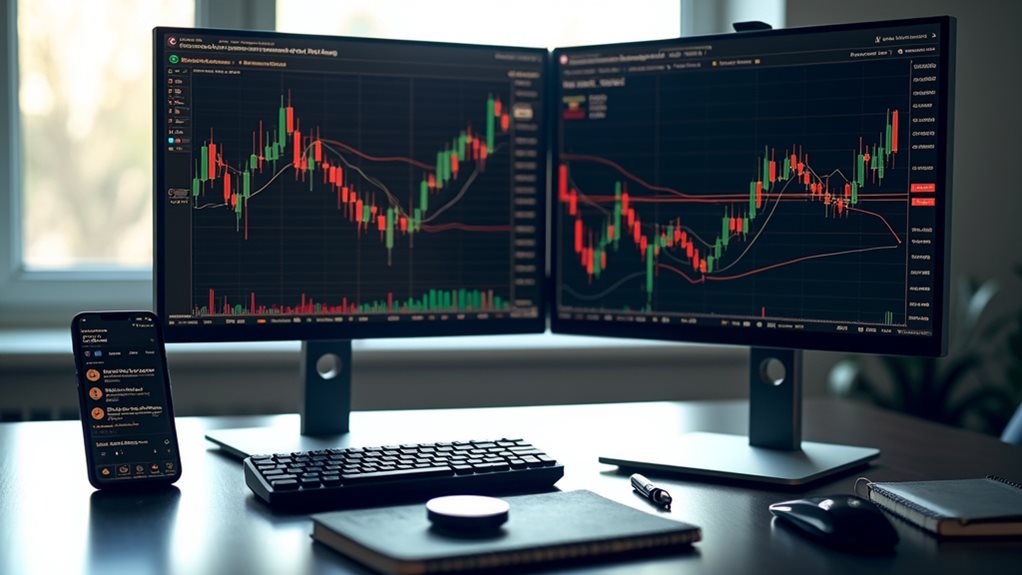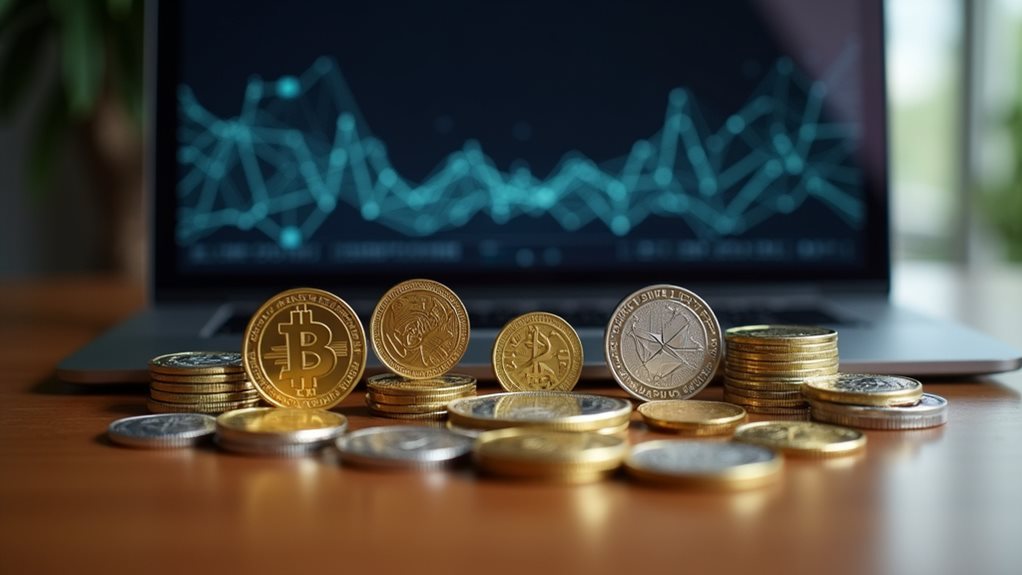Choose regulated exchanges for safety—period. Set up a secure wallet with two-factor authentication and back up your seed phrases (seriously, don’t skip this). Dollar-cost averaging beats emotional trading every time. Learn basic indicators like RSI and moving averages before risking real money. Diversify your holdings, stick to a 1% risk per trade rule, and never chase pumps. The pros didn’t build wealth overnight—they survived the crashes first.
Why You Should Choose Regulated Exchanges for Safety

While the Wild West appeal of crypto might tempt you to plunge into any exchange that promises moon-worthy gains, regulated exchanges are your best bet for not getting completely wrecked.
Seriously. Government oversight means someone’s actually watching your back when things go south.
When crypto markets implode, regulatory guardrails might be the only thing standing between you and financial oblivion.
Regulated exchanges offer real investor protection. When disaster strikes, you’ve got recourse.
Unregulated platforms? Good luck ever seeing your money again.
These legit platforms implement fraud prevention measures that matter—strict verification processes, security audits, and they don’t list random scam tokens hoping to separate you from your cash.
Enhanced security isn’t just marketing fluff here. Cold storage, encryption, and—shocker—actual insurance policies protect your assets.
Plus, transparency reports show you where your money’s actually going. Novel concept, right?
Hong Kong’s licensed exchanges have demonstrated zero incidents of collapse or missing executives, proving the value of strict regulation.
Stablecoin transactions have become the preferred vehicle for criminals with 63% of illicit transaction volume now conducted through these assets.
The FBI has documented nearly 150,000 crypto-related complaints with massive financial losses totaling $9.3 billion in just 2024 alone.
Setting Up a Secure Digital Wallet: Best Practices

How exactly do you keep your crypto from vanishing into the digital void? Start with wallet security basics: create ridiculously complex passwords and enable two-factor authentication immediately. No excuses.
For seed phrase storage, forget digital options—they’re hacker bait. Use metal backups stored in multiple physical locations. Trust me, your house burning down shouldn’t mean your crypto goes up in flames too.
Hardware wallets aren’t optional if you’re serious. They’re your best defense against both online threats and your own stupidity. Enable biometric authentication and remote wipe capabilities whenever available. The most secure approach is to diversify your crypto holdings between cold and hot wallets based on your usage patterns. Monthly security audits are essential to maintain the integrity of your wallet protection measures.
Update your wallet software religiously. Hackers love outdated code.
And please—stay vigilant against phishing attempts and insider threats. The guy messaging you about “verifying your wallet” isn’t your friend. Consider implementing zero-knowledge proofs for enhanced privacy when interacting with decentralized applications.
Dollar-Cost Averaging: The Beginner’s Strategy for Success

Despite what crypto influencers might tell you, timing the market perfectly is about as likely as winning the lottery while being struck by lightning.
Enter dollar-cost averaging—your emotional investing control superhero.
The concept? Dead simple. Invest fixed amounts at regular intervals—weekly, monthly, whatever. You’ll buy more when prices tank, less when they soar. Over time, your average cost drops.
No rocket science here. Just consistent, boring investments that actually work.
With market volatility reaching new heights in 2025, maintaining a disciplined approach has never been more crucial.
The dollar cost averaging benefits are obvious: less stress about timing, fewer panic sells, and protection from your own terrible impulse decisions. This strategy is particularly effective for long-term investment strategies in cryptocurrency, where market volatility is common.
Because let’s face it—your emotions are usually your portfolio’s worst enemy.
It won’t make you rich overnight. Nothing will. But it might keep you from going broke trying.
DCA can be easily implemented using automation tools available on most cryptocurrency platforms, making the process even more convenient and stress-free.
How to Read Basic Technical Indicators
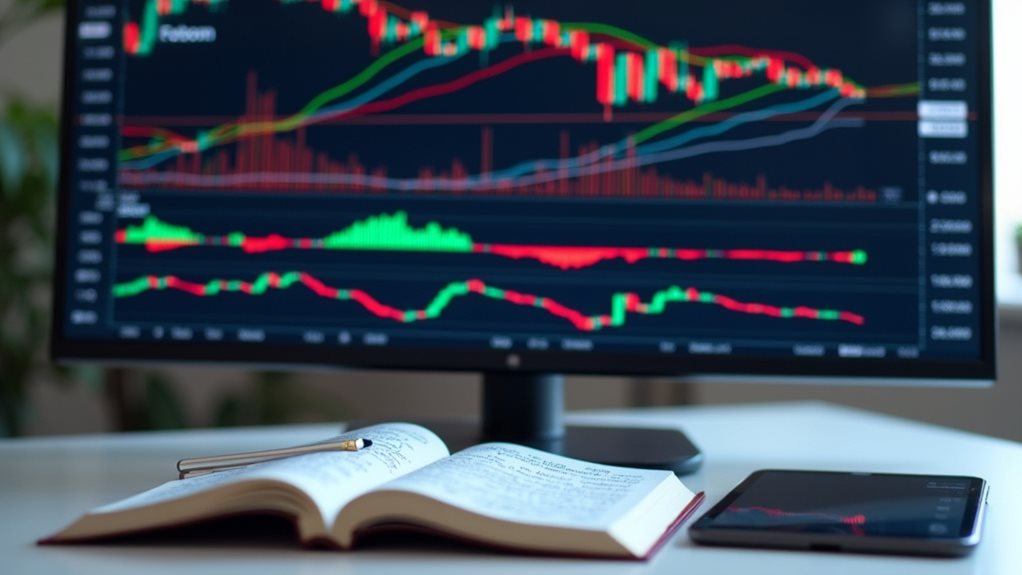
Technical indicators look like rocket science to newcomers, but they’re just fancy math formulas tracking price and volume. You’ll get the hang of them faster than you think.
- Moving Averages – Golden crosses make bulls smile, death crosses make bears dance. Simple as that. Market timing often leads to missed opportunities during volatile periods.
- RSI Interpretation – Above 70? Everyone’s buying like crazy. Below 30? Fear is everywhere. Perfect time to do the opposite.
- Volume Indicators – No volume, no party. Big price moves need big volume, or they’re just fake-outs waiting to trap you.
- MACD Fundamentals – When lines cross, people make moves. Watch for divergences – they’re telling you the trend is exhausted.
- Parabolic SAR – Those dots flip? The trend might be dying. Support becomes resistance. Magic, but not really.
Combining multiple indicators like RSI with MACD can help you build greater confidence in your trading decisions rather than relying on a single signal. Bollinger Bands can alert you to potential market volatility by measuring the standard deviation of price from the moving average.
Understanding Fundamental Analysis for Long-Term Value
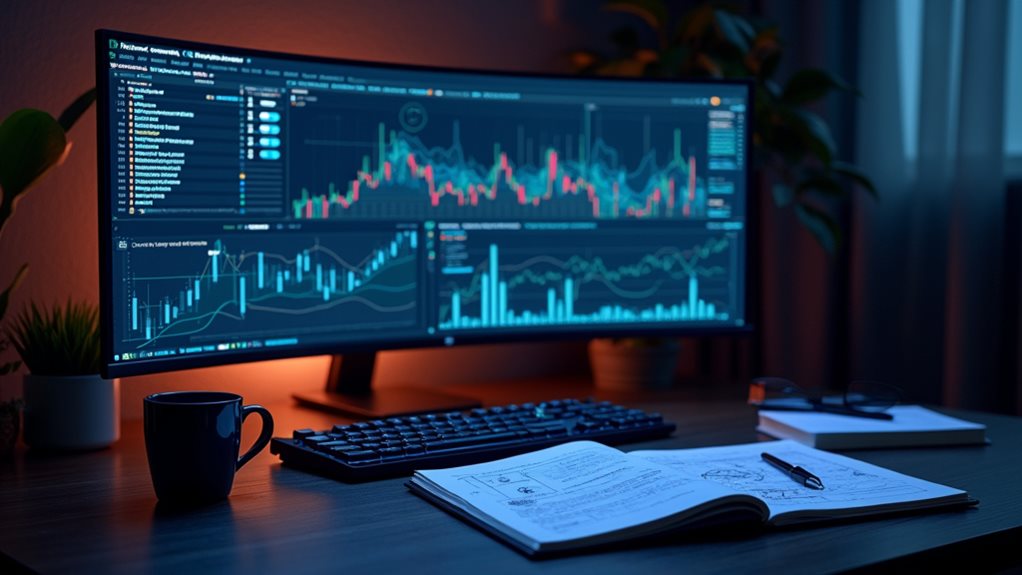
While price charts might hypnotize day traders, fundamental analysis digs beneath the hype to find actual value.
Don’t be fooled by flashy marketing and celebrity endorsements.
Start with the project fundamentals—study the whitepaper and roadmap.
Is the team delivering? Check their GitHub. Strong developer activity means they’re not merely tweeting—they’re building.
Like Ethereum’s transition to Proof of Stake, major protocol changes can significantly impact a project’s long-term viability.
Tokenomics analysis reveals hidden red flags. How’s the token distributed? A few whales holding everything? Run.
Community engagement matters. Dead Discord channels? Not promising.
Governance structures show who really controls things. “Decentralized” isn’t always so.
Never ignore market conditions or regulatory impacts. The best project can still fail with bad timing.
Compare the cryptocurrency’s intrinsic price to its current market value to identify potentially undervalued assets.
Examining both active addresses and transaction counts provides critical insights into genuine network usage and adoption.
Want sustainable gains? Do the homework. The chart-watchers will be long gone when you’re still collecting.
Essential Risk Management Rules Every Trader Should Follow
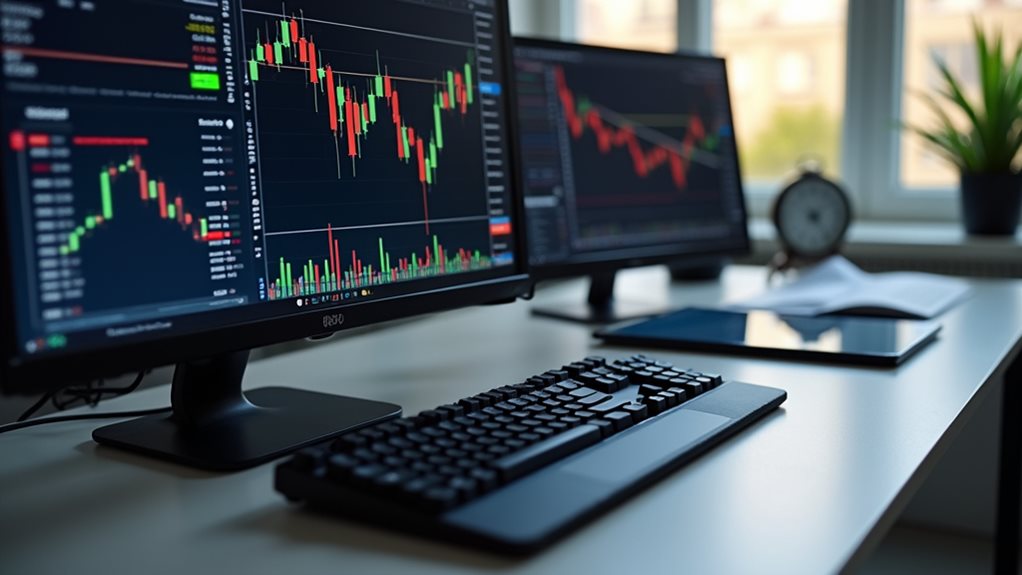
Risk management—your life jacket in crypto’s shark-infested waters. Without it, you’re just another statistic waiting to happen. Your trading discipline and risk tolerance aren’t just fancy terms—they’re survival tools.
Never risk more than 1% of your capital on a single trade. Period.
- Stop losses aren’t optional—they’re mandatory. Set them and don’t touch them, no matter how “sure” you feel.
- Diversify or die. Your “sure thing” altcoin might tank 80% overnight. Ask me how I know.
- Leverage? Proceed with extreme caution. It’s turned millionaires into paupers faster than you can say “liquidation.”
- Control your emotions or they’ll control your wallet. FOMO is expensive.
- Position sizing matters more than picking winners. Math doesn’t lie.
Consider using dollar cost averaging to make smaller, regular investments which can help average purchase prices over time and reduce the impact of market volatility.
For optimal trading performance, focus on peak activity during peak trading hours between 2:30 PM and 4:30 PM UTC on weekdays.
Regularly monitoring the exchange reputation is crucial to protect your assets from potential hacks or regulatory issues that could impact your investments.
Avoiding Common Beginner Mistakes in Crypto Markets
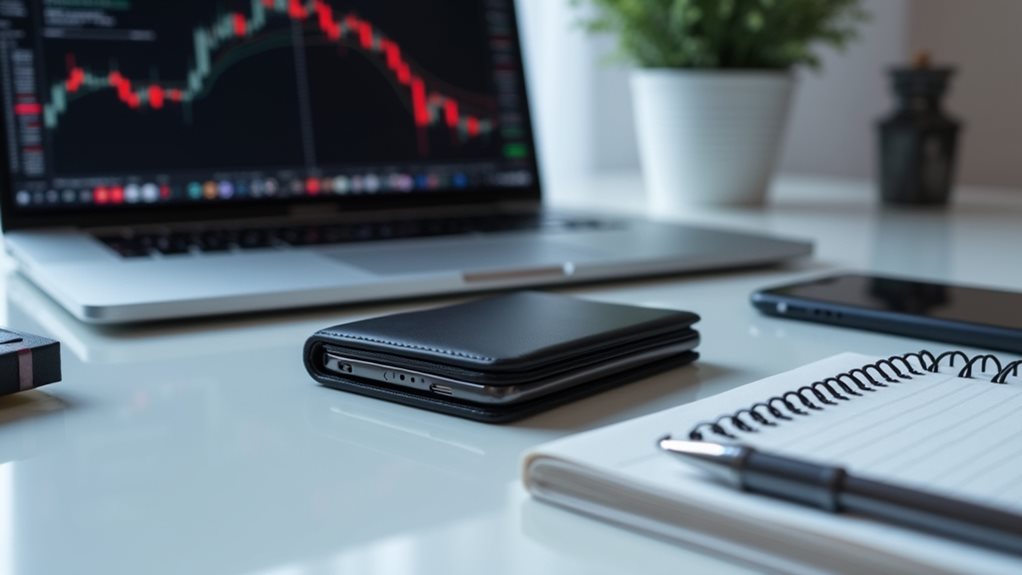
Even with solid risk management, beginners stumble into predictable traps that drain their wallets faster than a hole in a bucket.
Research pitfalls are everywhere—skipping whitepaper reading, ignoring market news, blindly following social media hype. Seriously, who buys something just because a meme told them to? Two-factor authentication adds an essential layer of security when conducting cryptocurrency research on exchanges.
Emotional pitfalls hit hard. FOMO drives buying at peaks, panic selling locks in losses. Trading discipline vanishes when revenge trading kicks in after losses. Take a break, for crying out loud!
Security negligence? Classic rookie move. Keep everything on exchanges and—poof!—gone in a hack. Hardware wallets provide significantly better protection by keeping your private keys offline. No hardware wallet, weak passwords. Amateur hour.
Strategic focus matters. Trading without goals equals gambling, plain and simple. Developing a structured approach to trading helps establish clear entry and exit points for better decision making.
Short-term thinking, ignoring fees, no trading journal. You’re not documenting mistakes? Guess you’ll make them twice.
Building a Diversified Portfolio With Limited Capital
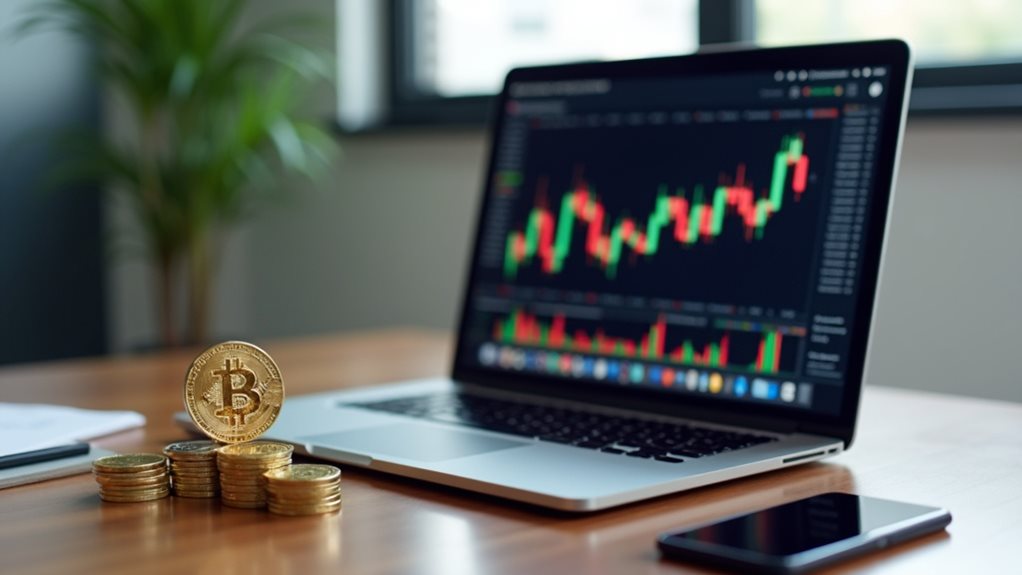
Despite what you might think, small bankrolls can build impressive crypto portfolios—you just need strategy, not stacks of cash.
Dollar-cost averaging is your friend. Buy Bitcoin and Ethereum first, then branch out.
Market cap diversification matters. Mix large, mid, and small-cap tokens. Consider starting with Mantra OM as it leads altcoin performance in 2025.
Sector allocation? Even more critical when funds are tight. Spread across DeFi, privacy coins, and smart contract platforms. Setting clear investment goals before purchasing any crypto will help you maximize your limited capital and avoid impulsive decisions. Consider your risk tolerance when determining the right mix of stable and volatile assets for your portfolio size.
- Your tiny portfolio isn’t doomed—it might outperform bloated ones
- Stablecoins aren’t boring—they’re your secret weapon during crashes
- Over-diversification is poison for small accounts—focus!
- Bitcoin isn’t “too expensive”—fractional investing exists, dummy
- DCA isn’t sexy—but it beats the pants off emotional lump-sum buying
Rebalance regularly. Stay disciplined.
Small capital doesn’t mean small returns.
When to Use Automated Trading Tools (And When Not To)

How often have you watched perfect trading opportunities slip through your fingers because you were asleep, busy, or just plain slow?
Enter automated trading. These bots execute hundreds of trades daily with win rates up to 91% versus your measly 43% manual success rate.
They shine in trending markets, reducing emotional errors by 96%. Perfect for high-frequency trading and 24/7 market monitoring. Your human brain can’t process millions of data points per second. Sorry. With current market liquidity declining, automated systems help maintain consistent trading volumes.
Studies show these sophisticated systems have reduced transaction costs by 32% compared to traditional manual trading methods.
But they’re not magic money machines. Don’t use bots during unpredictable market volatility or if you lack technical knowledge. A misconfigured bot is financial suicide.
And those “guaranteed profit” bots from sketchy Telegram groups? Yeah, they’re scams. Bots require oversight—”set and forget” is code for “lose your money.” For effective performance management, experts recommend monitoring every 4 hours against established benchmarks.

While trading bots execute based on cold, hard algorithms, social media moves markets with hot, messy emotions. Your portfolio can skyrocket or crash based on a single tweet from Elon Musk. No joke. Sentiment analysis tools track social media influence across platforms, giving you insight before prices swing wildly.
- Crypto Twitter isn’t just noise—it’s literally moving billions in market cap daily
- That “expert” with 50K followers? Probably paid to shill that new coin
- Pump-and-dumps spread like wildfire because FOMO is a hell of a drug
- When sentiment turns negative, panic selling happens FAST
- Major coins like Bitcoin respond differently than small-cap altcoins to social hype
Recent hardware wallet thefts highlight why flaunting crypto wealth on social platforms puts investors at serious risk.
The contrarian strategy can be particularly effective when extreme market sentiment creates buying or selling opportunities that go against the crowd.
Online communities like Discord and Reddit have become essential for early token support that can propel new projects into mainstream exchanges.
Remember: by the time everyone’s talking about a coin, smart money has already moved.
Frequently Asked Questions
How Do Crypto Taxes Differ From Traditional Investment Taxes?
Unlike stocks, your crypto tax implications include more taxable events: trading between cryptos, using crypto for purchases, and receiving mining rewards all trigger taxes. Crypto’s classified as property, not securities.
What Are Hardware Wallets and Why Are They More Secure?
Hardware wallets are physical devices that store your crypto keys offline. They’re more secure because they keep your keys in cold storage, protecting them from online threats while giving you complete control over your assets.
How Do Airdrops and Forks Affect My Investment Strategy?
Airdrops offer you free tokens and portfolio diversity as benefits, while forks can create unexpected value in your holdings. Both require careful security practices and tax planning to maximize their implications on your strategy.
When Is the Best Time of Day to Execute Crypto Trades?
Trade during U.S.-European market overlap (1:00-5:00 PM UTC) when trading volume peaks. You’ll find better liquidity mid-week, while avoiding weekends when market volatility increases but institutional participation decreases.
How Do I Recover My Crypto if I Lose My Private Keys?
Without your private keys, recovery is extremely difficult. You’ll need to rely on backup methods you’ve previously set up, like social recovery, encrypted backups, or hardware wallet alternatives. Always prioritize crypto wallet security to prevent future losses.
